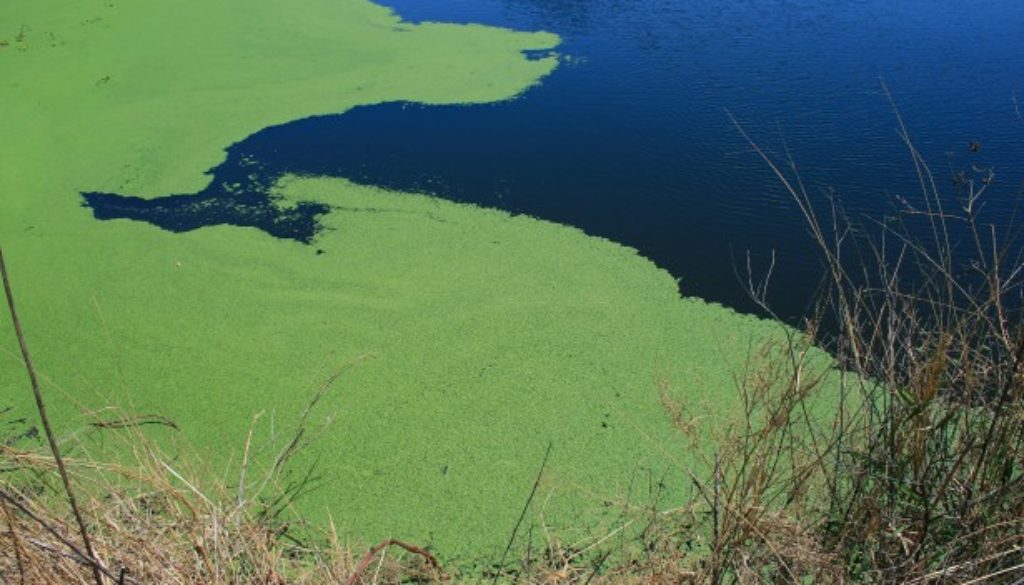Lake Erie’s Toxic Algae Breaks Records in 2015
By Rob Moore, Natural Resources Defense Council
The toxic algae bloom on Lake Erie was the most severe this century. That news was delivered by the scientists at the National Oceanic and Atmospheric Administration (NOAA) who make it their business to know about water quality on Lake Erie. And these all-too-regular record setting blooms illustrate what happens when you add the impacts of climate change to existing water quality problems.
The bloom reached its maximum size in August with a dense scum of toxic blue-green algae covering about 300 square miles of the Lake’s surface. While this year’s bloom didn’t cover as much of the lake as it did back in 2011, the density of blue-green algae was much higher, so the scummy factor was high compared to previous years, when the bloom’s grossness was limited to making the water look like pea soup.

The problems on Lake Erie aren’t going away anytime soon.
First, the amount of phosphorus going into western Lake Erie needs to be ratcheted down. In recent years, the amount of phosphorus coming from the Maumee River and other tributaries in Ohio has been climbing. And runoff into Lake St. Claire, immediately to the north, also had problems with blue-green algae blooms this summer.
Second, climate change is making Lake Erie summers warmer, making conditions perfect for growing a dense scum of toxic blue-green algae. Climate change also means that Ohio will experience many more severe storms, like those that caused the spike in phosphorus that pushed the Lake into “dense scum” territory.
This year wasn’t shaping up to be such a bad year for blue-green algae. In late May NOAA scientists were forecasting a bloom a bit worse than the one in 2012 — a year when severe drought decreased runoff and we had the smallest blue-green algae bloom on Lake Erie since 2007.
A few weeks later, the forecast had changed dramatically. Big storms that rolled through the area in June caused a huge amount of runoff from agricultural lands in the Maumee River and other tributaries. In about a month, phosphorus levels in Lake Erie more than doubled, and nearly tripled. NOAA updated its toxic algae bloom forecast, predicting that the second largest bloom in a century was likely to occur. As it turned out, Lake Erie had the worst outbreak of blue-green algae this century.
 NOAA Image from NOAA Projection08, July 9, 2015
NOAA Image from NOAA Projection08, July 9, 2015
From a purely technical standpoint, it’s possible to do something about the levels of phosphorus. But cleaning up nutrient pollution has proven to be difficult across the country, especially when it comes to agricultural lands. One important way to help remove nutrients is to protect wetlands that can help remove phosphorus before it gets into a stream. The Clean Water Rule is one tool that will help protect these kinds of areas.
Any cuts in phosphorus also need to assess how climate change affects the future. Warmer air temperatures will mean warmer water temperatures (in the future Ohio will begin to feel much more like Kentucky or Tennessee in the summer). Blue-green algae thrive in warm stratified water, like you find on Lake Erie in the summer. Lower levels of phosphorus may be able to kick off similar blooms as the water warms.
It’s worth noting that those same rains that flushed so much phosphorus into Lake Erie, also caused alot of flooding. Some of the solutions that would eliminate phosphorus runoff would also decrease the risk of flooding due to severe weather.
Toxic blue-green aren’t a problem limited to Lake Erie. Lake Champlain, many lakes in New York State, and various parts of the Great Lakes have recurring problems with these outbreaks. There isn’t one single solution that can fix the problem. A suite of solutions will be needed. Lake Erie is the most dramatic example of how water quality suffers as a result of phosphorus pollution, and how those problems get even worse as the climate changes. Lake Erie’s condition serves as a warning we shouldn’t ignore.

